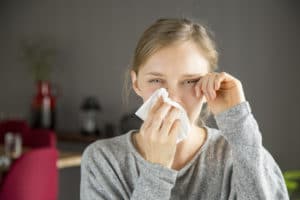
Dry Eye
The eyes are not meant to be dry. They rely on a healthy tear film to function well and maintain a nice degree of comfort. Tears look watery, but they are actually a mixture of three different substances. The tear film has water, lipids (oils) and mucin (mucus). The three substances must be present in the right ratios for the ocular surface to stay adequately lubricated. Without sufficient lipids and mucin, the tear film dries out too quickly and symptoms occur. Lipids are produced by the meibomian glands that are situated at the edge of the eyelids. In most cases of dry eye, it is a blockage in these glands that is to blame. However, the symptoms of dry eye, including redness, excessive tearing, a gritty feeling, and a burning sensation, may also relate to a medical condition. A thorough ophthalmic exam of the eyes and meibomian glands can determine if a blockage is to blame.
Allergies
Ocular allergies can cause some of the same symptoms as dry eye disease. However, the one prominent indication that sets allergies apart is itching. Ocular allergies may occur as sensitivity to any number of allergens. Common triggers include dust mites, pet dander, and pollen.
Treatment for Symptoms of Dry Eye or Allergies
It is important to differentiate between dry eye disease and allergies because treatment will vary based on diagnosis. For allergies, an antihistamine may be recommended to prevent the release of histamine that results in symptoms. Some sufferers also use eye drops and cool compresses to soothe irritation.
Treatment for dry eye disease revolves around unblocking impaired meibomian glands so tear film production resumes. We offer two meibomian gland treatments, LipiFlow and EyeXpress, to comfortably treat this condition.
Get the help you need for dry eye disease in our comfortable Amarillo office. Call (806) 351-1177 to schedule your visit with board-certified ophthalmologist Dr. Murrell.
